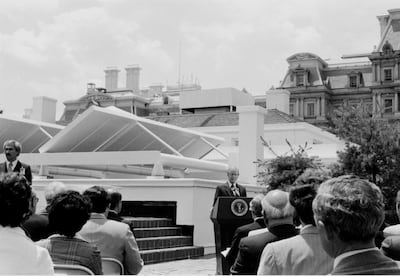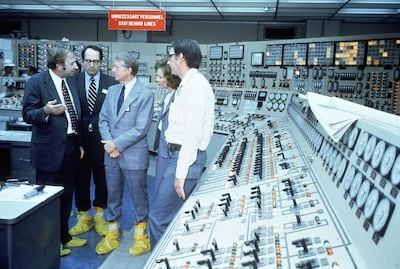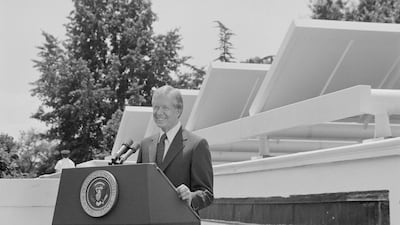While countless articles have been written by now remembering many moments of the late US president Jimmy Carter, few, if any, have focused on the notion that he holds a unique place as one of the first aspiring futurist American presidents.
It might seem like an odd juxtaposition with his overall campaign image of a folksy and accessible everyman, but hear me out, because there’s strong evidence to show that Carter pushed the envelope on everything from technology in the White House to graphic design on the campaign trail.
Where’s the proof that Carter looked to the future? Let’s look to the Sun for a moment. Solar panels are so prevalent in this day and age that it’s easy to dismiss them as cliched to some extent. That wasn’t the case in the late 1970s. Far from it. Yet that didn’t stop the Carter administration from attempting to make them common by putting them on one of the most storied rooftops in the US.
“Today by directly harnessing the power of the Sun, we’re taking the energy that God gave us, the most renewable energy that we will ever see, and using it to replace our dwindling supplies of fossil fuels,” said Carter in June 1979, during a news conference outside the White House where solar panels had just been installed on the building's roof for the first time.

“Solar energy will not pollute our air or water. We will not run short of it, and no one can ever embargo the Sun or interrupt its delivery to us,” said Carter, alluding to the 1973 oil embargo that still reverberated in the minds of many throughout the US.
The visual of glistening solar panels on the White House roof made a dent in the minds of many.
Yet, in this instance, one of numerous throughout his career, Carter was ahead of his time. It would take decades for solar technology to catch up with the lofty expectations of many researchers, and Carter’s defeat to Ronald Reagan, who favoured a more conventional energy policy, in the 1980 election sealed the fate of the solar panels. The Reagan administration eventually had them removed, though some of the panels would eventually land in various libraries and museums throughout the country for posterity.
In keeping with the energy theme, Carter’s flirtation with the future was apparent back in the 1940s, graduating from the US Naval Academy in 1946 among the top of his class, and eventually pursuing graduate work in nuclear physics, where he would be part of a pre-commissioning crew of a nuclear submarine. According to his biography, as well as the Historical Society of Ottawa, he even helped disassemble a damaged nuclear reactor on the brink of a meltdown in Canada. Keep in mind that nuclear energy and nuclear reactors weren’t exactly on the tip of every tongue at this point. Yet Carter was ahead of the curve.

His nuclear experiences would come full circle later in his presidency, in 1979 when a damaged nuclear reactor in Harrisburg, Pennsylvania known as Three Mile Island caused an unprecedented nationwide scare. It would have been easy enough for the 39th president of the United States to simply monitor the situation from Washington and let Pennsylvania state officials and the Nuclear Regulatory Commission handle it, but Carter, given his nuclear expertise, felt the need to make a point.
Wearing protective yellow boots amid the continuing fears of a potential radiation leak, Carter toured the Three Mile Island plant, flanked by the director of the US nuclear agency and the governor of Pennsylvania. The president, walking in his two-piece suit and radiation shield boots looked like an odd juxtaposition, but time was kind to the futuristic image and it is seared into the history books as a lesson in leadership.

On a less hazardous theme, Carter rode the wave of early personal computing shortly after he took office in 1977. For the first time, the Carter administration installed a computer in the White House, a Hewlett-Packard HP3000, according to California’s Computer History Museum.
That computer was accessible from various terminals placed throughout the White House. Although laser-printing technology was still very much in its infancy, the Carter White House also had an IBM laser printer installed. For perspective purposes, Apple didn’t ship a laser printer until 1985.

Last, but certainly not least for Carter’s affinity for grabbing on to the future, you have to look at his campaign signs, both from his first 1977 campaign and his ill-fated re-election campaign. They weren’t the traditional red, white and blue colour scheme, a staple of almost all US presidential campaign signs. The Carter campaign signs were green, and although it’s not clear why, it’s also not difficult to speculate.
The country, still reeling from the Watergate scandal, was looking for reform and green fits that mould. It’s also a clarion call for environmental wisdom, as well as for post-partisan politics. Quite simply, this wasn’t the usual campaign, this was a simple man named Jimmy Carter, and he wanted to run for president in 1976. The usual colours wouldn’t do. He needed something different, something forward-looking, and green fit that bill.
Despite only being a one-term president, Carter’s shadow has proven to be a daunting one to escape. While political pundits will undoubtedly point to mounting economic troubles and a significant charisma gap when trying to explain his failure to secure re-election, there’s also an important point to be made about his desire to be one step ahead, his fearless stride into the future, as a major reason why so many looked to his life with wonder.




